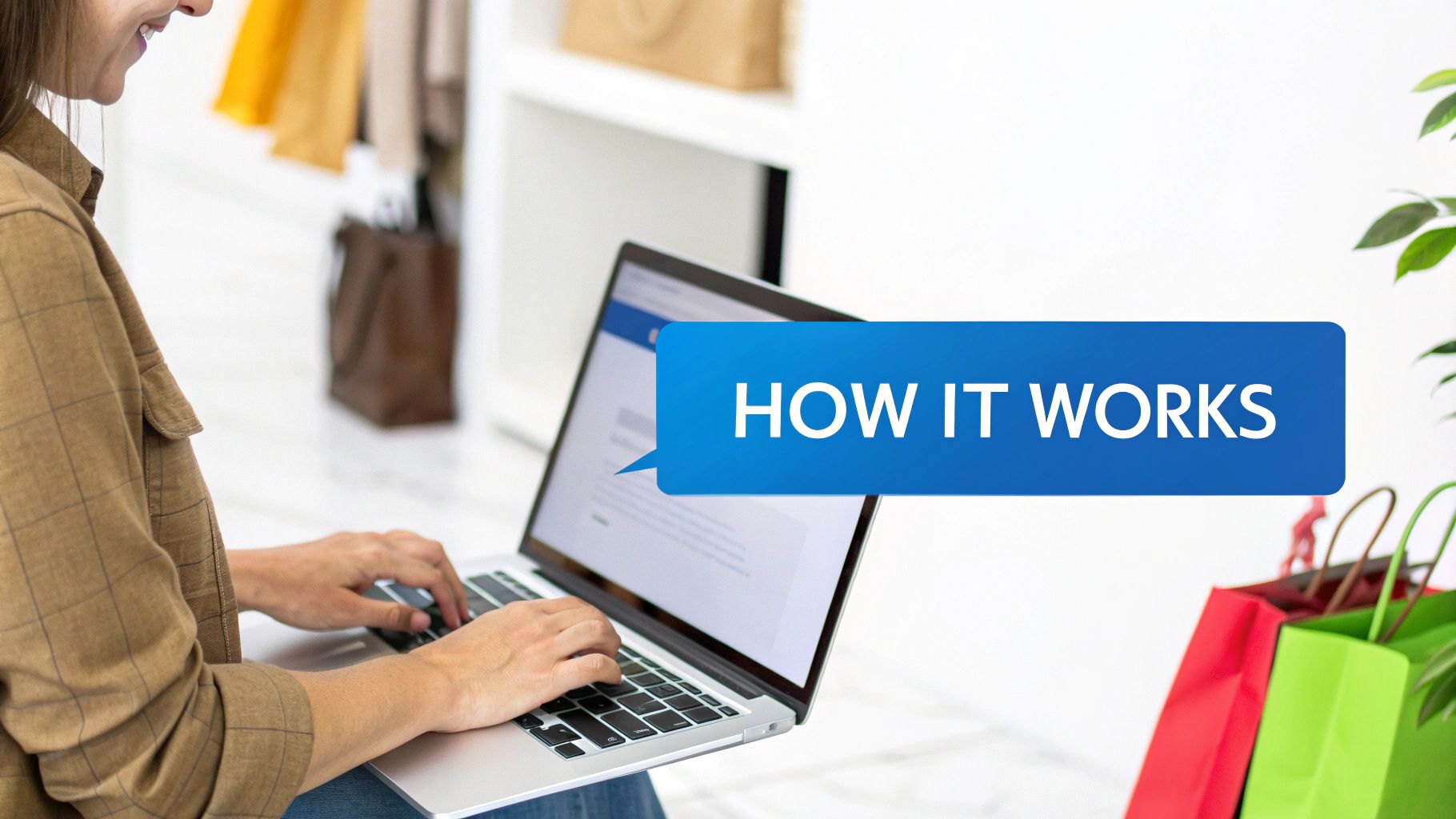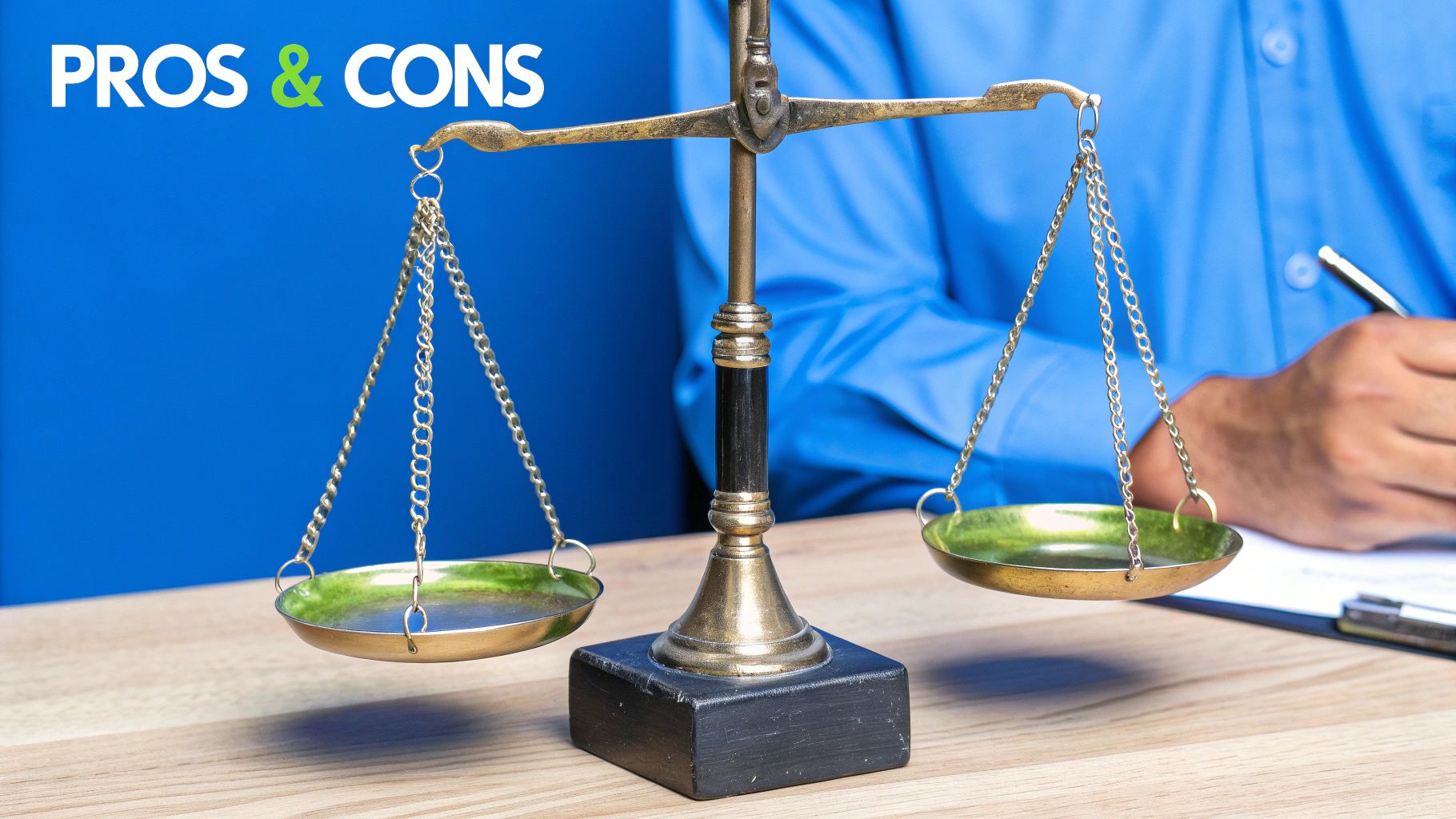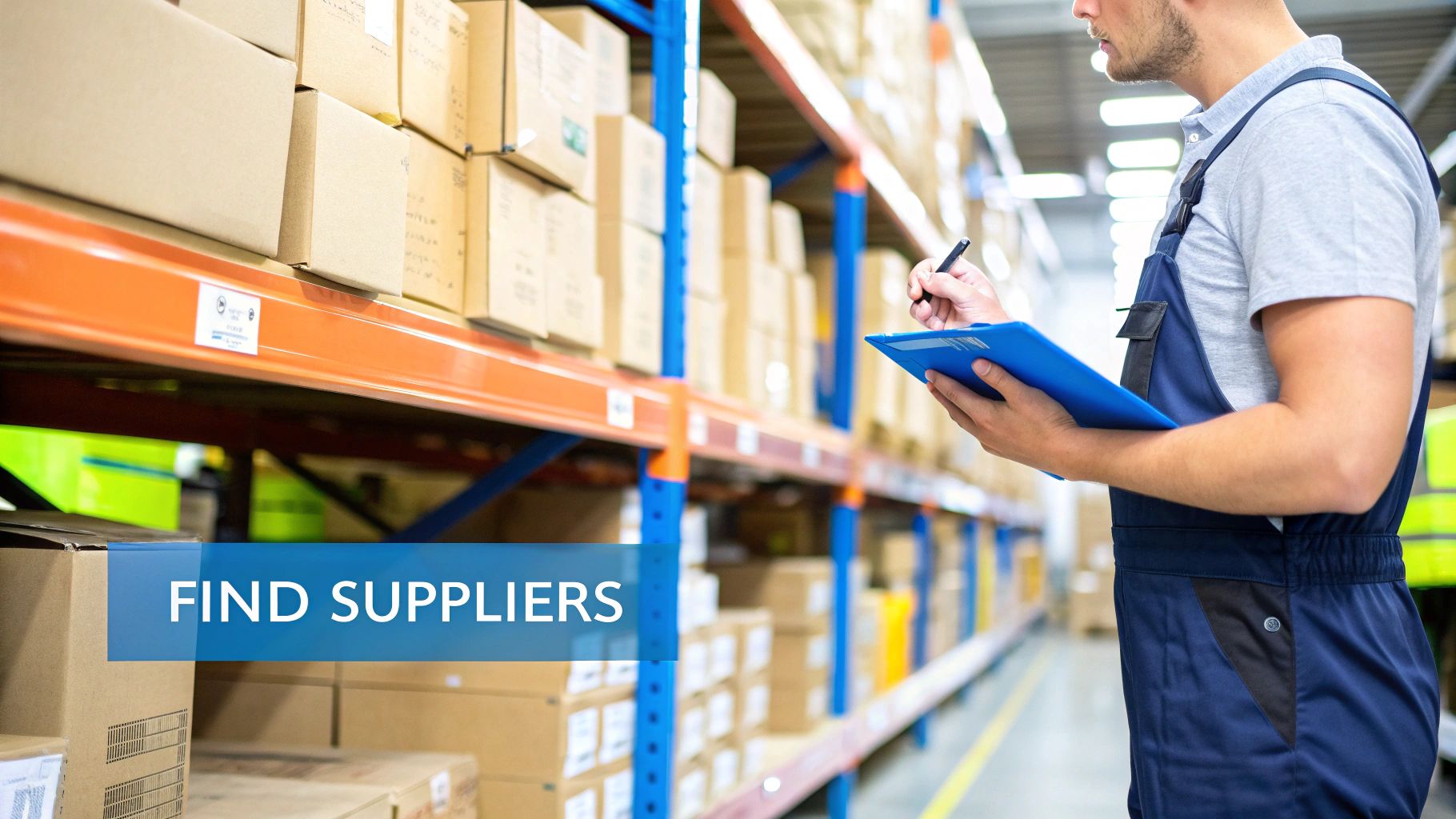Drop shipping is a surprisingly simple idea that has completely reshaped eCommerce. At its core, it’s a business model where an online store sells products that are shipped directly from a third-party supplier to the customer. The key takeaway? The store owner never handles the inventory. Instead, they act as a curator and marketer, profiting from the price difference between what the customer pays and what the supplier charges.
Think of yourself as a savvy personal shopper for the entire internet. You build a beautiful online store, meticulously curating products and crafting a strong brand identity. The twist is that you don't keep any of these products in a crowded warehouse or a spare bedroom. Your job is purely digital—all about marketing, sales, and creating a fantastic customer experience.
When a customer finds your store and makes a purchase, the real magic happens behind the scenes. You simply forward that order to your partner—a supplier, manufacturer, or wholesaler. This partner then handles all the physical work: picking, packing, and shipping the product directly to your customer's doorstep.
This setup creates a hands-off approach to inventory, which is a massive draw for new entrepreneurs. You essentially sell a product first and only purchase it from the supplier after you've already been paid by the customer. Your profit is the margin you build into your retail price. For example, if a supplier charges you $15 for an item and you sell it for $40, your gross profit is $25.
This infographic breaks down the simple, three-step flow of a typical drop shipping order.

As you can see, the retailer’s main job is connecting the customer with the product. Meanwhile, the supplier takes care of the entire physical fulfillment process. This clear separation of duties is what makes the drop shipping model work.
To succeed with this model, it’s critical to understand who is responsible for what. As the seller, you are the face of the business. You manage everything the customer sees: the website, marketing campaigns, and all communication, including any returns or support questions. Your supplier, on the other hand, is the invisible backbone of the operation.
The customer interacts solely with your brand and is often unaware that a third-party supplier is even involved. This means the supplier's reliability—from product quality to shipping speed—directly reflects on your business's reputation.
To make it even clearer, let's break down the distinct responsibilities for everyone involved in a drop shipping transaction.
This table summarizes who does what in a standard drop shipping partnership.
Understanding these roles is the first step, but there's a lot more to building a successful brand with this model.
For a deeper dive into the mechanics and strategies, check out our comprehensive drop shipping guide to get started.

Every business model comes with trade-offs, and drop shipping is no exception. It offers an incredibly tempting path into eCommerce, but before you dive in, it’s crucial to look at both the highlights and the hurdles. Getting a clear, balanced picture is the only way to know if this model truly fits your goals and resources.
The biggest draw is obvious: it smashes the traditional barriers to starting a business. You can launch a fully functional online store with very little upfront cash because you don't have to buy inventory. This sidesteps the classic retail pitfall of tying up thousands of dollars in products that might not sell.
The perks of this asset-light approach are a game-changer for new entrepreneurs. It’s not just about saving money—it's about gaining speed and flexibility right out of the gate.
This lean model lets you pour your limited time and budget into the things that matter most at the start: marketing your brand and finding customers. You get the freedom to experiment with different products and niches without the looming fear of a garage full of stuff nobody wants.
Of course, that convenience comes at a price. The same low barrier to entry that makes drop shipping so attractive also means you'll face a ton of competition. When anyone can set up a store overnight, marketplaces get crowded fast, driving down prices and making it tough to stand out.
The most significant trade-off is often found in your profit margins. Since you are buying single items from a supplier instead of purchasing in bulk, your cost per item is higher, typically leading to margins between 15-30%.
Beyond profits, you also give up a huge amount of control over the customer's experience. This becomes a real headache in a few key areas:
The model's power is undeniable; over 27% of online retailers now use drop shipping for fulfillment. But the intense competition means the odds are stacked against newcomers—only about 10% of new drop shippers find success in their first year. You can explore more dropshipping facts and figures to get a better feel for the market landscape.

In the world of drop shipping, your suppliers are the invisible foundation of your entire brand. Think of them as the behind-the-scenes crew that makes the magic happen. Their performance—from product quality to shipping speed—directly shapes your customer's experience and, ultimately, your reputation.
Choosing the right partner isn't just a setup task; it's one of the most critical strategic decisions you'll make.
The hunt for a great supplier usually kicks off in one of two places: massive online directories or more focused, specialized manufacturers.
No matter your industry, securing reliable partners is non-negotiable. It pays to learn some proven strategies for vetting suppliers before you start. The core principles of evaluating a good partner are the same whether you're selling fine jewelry or fitness gear.
Once you have a shortlist of potential suppliers, the real work begins. Never take a supplier's promises at face value. A thorough evaluation process is your best defense against shoddy products, snail-paced shipping, and a wave of unhappy customers.
Treat this step like you're hiring a key team member. Because you are. Your goal is to get a feel for their entire operation before you ever list one of their products for sale. This means asking tough questions and, most importantly, testing them out yourself.
Always order samples. This is the non-negotiable, golden rule of vetting suppliers. There's simply no substitute for holding the product in your hands. It's the only way to truly judge its quality, inspect the packaging, and time the entire shipping process from your customer's point of view.
Before you commit, run every potential supplier through this practical checklist. How they respond—and how quickly—will tell you everything you need to know about what it’s like to work with them.
Finding a good supplier isn't just about finding the cheapest product. It’s about finding a true partner who is invested in helping your brand succeed and grow.
Alright, you've got your suppliers lined up. Now comes the fun part: building your digital storefront. This is more than just a technical task—it's where you create a genuine brand experience, a place where customers feel completely confident pulling out their wallets. The platform you choose is the bedrock of your entire business, directly shaping how you'll manage day-to-day operations.
Most new drop shippers lean on platforms like Shopify or WooCommerce for good reason. They're built to be user-friendly and have massive ecosystems of apps. This is key, because you'll use specialized apps like DSers (for AliExpress) or DropCommerce (for North American suppliers) to connect your store directly to your supplier's inventory. This connection is what makes the magic happen, automatically forwarding orders and keeping your operations from becoming a chaotic mess.
Let's be blunt: a professional-looking website is non-negotiable. No one is going to hand over their credit card info to a site that looks like it was thrown together in an afternoon. Your primary goal is to build a clean, easy-to-navigate store that showcases your products and screams "trustworthy" from the moment a visitor lands.
This really boils down to a few critical elements:
Remember, your website is often the only interaction a customer has with your brand. Every element, from the logo to the checkout button, must communicate reliability and quality. This is a core part of any successful brand's journey, which you can explore in our complete e-commerce fulfillment guide.
One of the biggest rookie mistakes in drop shipping is simply copying and pasting the supplier's product descriptions. These are almost always poorly written, uninspiring, and—worst of all—used by hundreds of other stores selling the exact same thing.
You have to write your own unique descriptions to stand out. Don't just list features; sell the benefits. Tell a story. Explain how this product solves a problem or makes the customer's life better. Use persuasive language and smart formatting, like bullet points and bold text, to make the key selling points pop. This is your single best chance to inject your brand's personality into a generic product and connect with your audience on an emotional level. It's how you turn "a product" into "your product."

Drop shipping is so much more than a side hustle—it's become a massive, powerful engine within the global retail world. Its explosive growth isn't a fluke. It's being supercharged by the rise of social commerce, key breakthroughs in logistics, and a permanent shift in how people shop online.
And this isn't just a flash in the pan. The global dropshipping market was recently valued at a staggering USD 365.67 billion and is on track to hit USD 464.44 billion with a growth rate over 22%. Looking ahead, projections show the market will blast past USD 1.25 trillion by 2030, proving its staying power. You can explore the full picture of these market growth projections for yourself.
Several powerful forces are coming together, making it clear that knowing what drop shipping is remains a vital piece of any modern e-commerce strategy. Sure, the low barrier to entry still pulls in new entrepreneurs, but the real story is how the entire ecosystem around it is maturing.
Here are the main trends driving this evolution:
These trends all point to a more sophisticated, professional future for drop shipping. Success will increasingly hinge not just on finding a hot product, but on building an operation that’s resilient, efficient, and relentlessly focused on the customer.
It's this focus on operational excellence where many growing brands hit a wall. As sales pick up, the standard drop shipping model can start to show its cracks, revealing weaknesses in shipping reliability and brand control.
For businesses that are ready to scale, this is usually the moment they start looking for more robust fulfillment solutions. If this sounds familiar, you might want to learn why you should consider a 3PL for your eCommerce fulfillment to keep your growth on track. By understanding where the market is headed, you can position your brand for long-term success.
Drop shipping is an incredible launchpad, but what happens when your brand really takes off? The very model that gave you a low-cost start can begin to hold you back as order volumes climb and customer expectations for speed and quality intensify.
For growing businesses, this is a critical moment. Sticking with the standard drop shipping model can mean sacrificing control over shipping times, product quality, and the overall customer experience. This is where the next strategic step often comes into focus: partnering with a Third-Party Logistics (3PL) provider.
Transitioning to a 3PL is like graduating to the next level of e-commerce. Instead of relying on your supplier to ship individual orders, you purchase inventory in bulk and have it managed by a specialized partner. This hybrid approach really gives you the best of both worlds.
The core idea is simple: You own the inventory, gaining full control over profit margins and product quality. Your 3PL partner handles all the complex physical operations—warehousing, picking, packing, and shipping—with professional efficiency.
This shift puts you back in the driver's seat of the customer experience. You are no longer at the mercy of a supplier's generic packaging or sluggish processing times. A 3PL allows you to create a superior, branded unboxing experience with custom boxes, promotional inserts, and thank-you notes that build lasting loyalty. You can find out more by exploring what a 3PL is in this complete guide to third-party logistics.
This move marks the evolution from a drop shipper to a true brand owner. It allows you to scale your operations smoothly without getting bogged down by the daily grind of fulfillment logistics. You get to focus on what you do best—marketing, product development, and growing your business—while your 3PL ensures every order goes out perfectly.
Even after you get the hang of the basics, a few key questions always pop up for aspiring entrepreneurs. It's totally normal. Let's tackle the most common ones about profitability, startup costs, and the biggest pitfalls you'll want to avoid.
Yes, absolutely—but profitability comes from smart strategy, not just the business model itself. Don't expect traditional retail margins. With drop shipping, you're typically looking at a profit margin between 15% and 30%.
Because the margins are tighter, your success hinges on a few key things: driving a high volume of sales, keeping a close eye on your marketing spend, and picking a niche with steady, healthy demand. Think of it this way: profitability is less about the model and more about how skilled you are at marketing and managing your supplier relationships.
The most frequent—and costly—mistake new drop shippers make is failing to properly vet their suppliers and test the products. Many beginners simply import items from a directory without ever ordering a sample.
This is a shortcut that often leads to disaster. Selling low-quality goods results in a flood of customer complaints, high return rates, and can do irreversible damage to your new brand’s reputation. Always, always test your products and communicate thoroughly with your suppliers before you list anything for sale.
While drop shipping has a famously low barrier to entry, it's not completely free. You'll have a few non-negotiable costs right out of the gate.
Your main expenses will be your e-commerce platform subscription (a Shopify plan, for example, starts around $29/month), a custom domain name (about $15/year), and a marketing budget to get your first customers in the door.
To be safe, a realistic starting budget is somewhere in the $300-$500 range. This gives you enough cushion to cover the initial setup and run some small ad tests to see what works.
As your brand grows beyond the drop shipping model, managing your own inventory with a trusted partner is the key to scaling effectively. Simpl Fulfillment provides the expert logistics and custom-branded fulfillment that turn one-time buyers into loyal fans. Learn how Simpl can elevate your brand today.